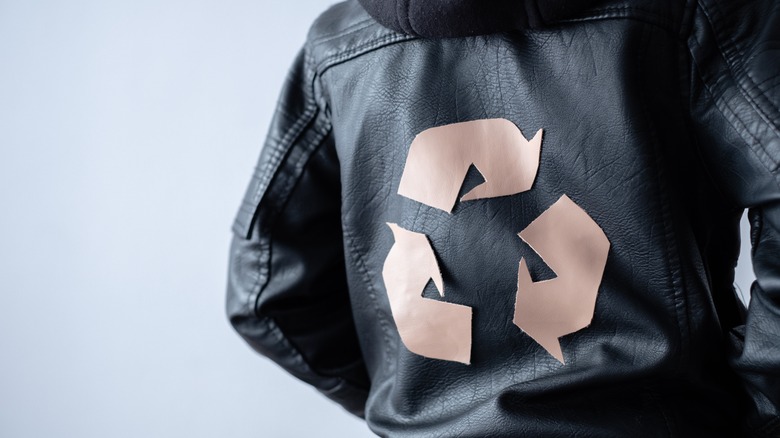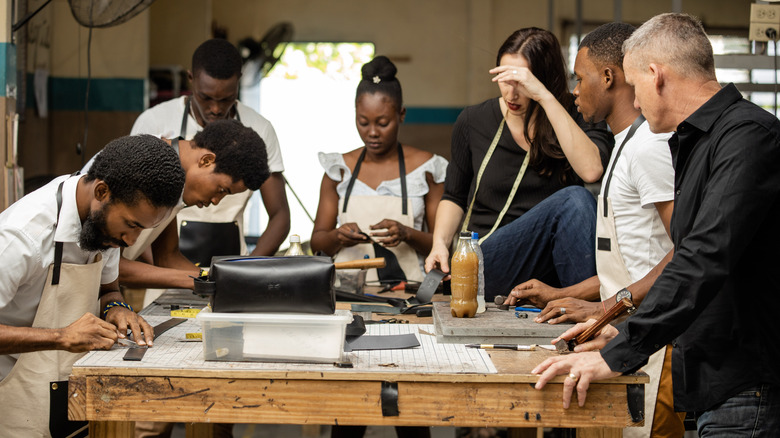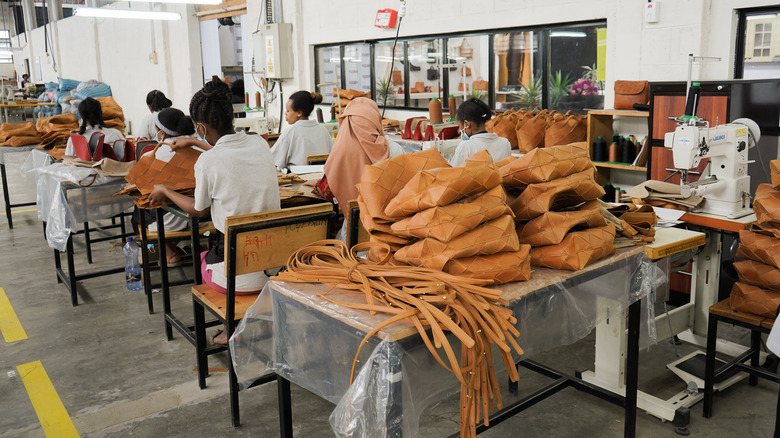What To Look For When Shopping For Sustainable Leather
Leather has been used for its function and its fashion for millennia. Researchers have found evidence of leather-working tools made by Neanderthals dating back over 40,000 years, as reported in Nature. Interestingly, as the outlet points out, a similar tool is still in use today by the likes of luxury leather goods maker Hermès. Clearly, the material has been a mainstay for eons, and it's not hard to understand why.
However, leather isn't without its problems. Real leather comes from animal hides, and some are reluctant to purchase it because of the potential for animal cruelty in the industry, per The Guardian. And in a world where eschewing animal products and going vegan can have benefits in regard to climate change, wearing leather is seen by some as a bad choice when it comes to caring for the planet, according to Harper's Bazaar.
This has helped give rise to vegan leather, although the sustainability of vegan leather can also be complicated. Many vegan leather products are made from petroleum-derived materials like polyurethane (PU), which can take hundreds of years to biodegrade, per Popular Science. There are some vegan leathers made from things like mushrooms, but they're not as ubiquitous.
Luckily, there are more options. If you're in the market to buy real leather goods, there's a way to do so that maximizes sustainability, and The List spoke with three experts about what to look for when seeking out ethical leather fashion.
Choose long-lasting leather products
If you have a high-quality leather piece and you take care of it, it can last for your entire life and even be passed down to future generations, per MasterClass. And, if it's quality leather that's taken care of and used for a long time, it's the opposite of fast fashion.
The List spoke with Matt Stockamp, Sustainability Lead at Nisolo, about sustainability and leather — Nisolo started by selling leather shoes made in Peru, and though it has now expanded its offerings, they still maintain a continued dedication to sustainability, according to Forbes.
"Leather has a relatively low carbon footprint per use due to its long lifespan," Stockamp said. And he noted that when you buy a leather product, make sure it's one "you plan to use for several years." Meaning, you should check micro-trends off your list when it comes to leather goods.
But the bonus to keeping a long-term leather item (in addition to being better for the planet) is that over time, quality leather will pick up a patina that will give them a unique look and personality, per Popov Leather. Stockamp adds, "care for your leather by maintaining it, and lastly, dispose of it responsibly by giving it to an organization that will recycle it."
Not all leather is created equally
When it comes to sustainability and leather, there's more you can do when choosing a product for its durability and potential for long-lasting use.
Julie Colombino-Billingham is the founder and CEO of Deux Mains, which makes ethically sourced leather handbags, sandals, and jewelry in a solar-powered factory in Haiti. Colombino-Billingham told The List that leather can get a "bad rap when it is abused, over-consumed, over-processed, and made in places where people and the planet are put in harm's way. Like anything, leather can be an unacceptable raw material."
Seeing leather as something that needs to be sourced and treated a certain way to be sustainable is a sentiment shared by Ian and Brittany Bentley, founders of Parker Clay. Parker Clay features a great lineup of handcrafted Ethiopian leather bags, and they focus on making lifetime-guaranteed leather products in a way that makes the world a better place. In terms of placing leather goods in a larger context of consumerism and sustainability, the Bentleys said that for them, "it's important that when we think of producing anything, that people and the planet are valued as much as the end product. For years, companies have optimized on the lower prices or materials, but it's come at the cost of people and the planet."
Look for third-party certifications and transparency
Take the time to find out where the leather is manufactured, and its rating in terms of sustainability. Both Matt Stockamp with Nisolo and Julie Colombino-Billingham of Deux Mains suggest that consumers use the Leather Working Group (LWG) as a guide. The mission of LWG includes providing "a globally recognized certification standard representing responsible leather sourcing." Their certifications focus on the environmental and social impacts of a tannery, including traceability, and their highest rating is the Gold Standard.
Another way to find out about the impact of a company is with the Certified B Corporation designation, which helps consumers see how a company treats their workers, the community they're in, and the planet. It's not, however, specific to leather goods.
An additional aspect of leather and sustainability is how and where the animals were raised. For Parker Clay's founders, they pride themselves on using "local Ethiopian providers who treat their animals with care and respect." They also use animals "that are first a local product of the meat industry... helping ensure no part of the animal is wasted." Locally sourced leather also reduces the overall climate impact since it lessens the amount of carbon emissions produced when getting the material to the manufacturer. Look for a commitment to transparency regarding how the leather was sourced and made.



